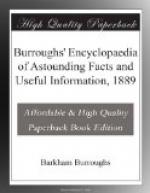Qualities of Building Stone.—The principal qualities of a good building stone are—(1) Strength, (2) hardness, (3) durability, (4) appearance, (5) facility for working. There are also other minor points; but stone possessing one or more of the above qualities, according to the purpose for which it is required, may be regarded as good for that purpose.
Strength of Stone.—Stone should only be subjected to a compressive strain. It is occasionally subject to a cross strain, as in lintels over doors and windows; these are, however, contrary to the true principles of construction, and should not be allowed except a strong relieving arch is turned over them. The strength of stone in compression is about 120 tons per square foot for the weakest stones, and about 750 tons per square foot for the strongest. No stones are, however, subjected to anything like this amount of compressive force; in the largest buildings it does not amount to more than twelve or fourteen tons per square foot.
Hardness of Stone.—This is of more importance than its strength, especially in pavements or steps, where it is subject to great wear; also in plinths and quoins of buildings where it is desired to preserve a good face and sharp arris. The order of strength and hardness of stone is—(1) Basalt, (2) granite, (3) limestone, (4) sandstone. Granite, seinite, and gneiss take the first, place for strength, hardness and durability, but they will not stand a high temperature. “Stones which are of a fine, uniform grain, compact texture and deep color are the strongest; and when the grain, color, and texture are the same, those are the stongest which are the heaviest; but otherwise the strength does not increase with the specific gravity.” Great hardness is objectionable when the stone has to be worked with a chisel, owing to the labor required to work it. Hard stones, also, generally wear smooth, and become polished, which makes them unsuitable for some purposes. Brittleness is a defect which frequently accompanies hardness, particularly in coarse-grained stones; it prevents them from being worked to a true surface, and from receiving a smooth edge at the angles. Workmen call those hard stones which can only be sawn into slabs by the grit saw, and those soft which can be separated by a common saw.
Expansion of Stone by Heat.—Rocks are expanded by heat and contracted by cooling. Variation in temperature thus causes some building stones to alternately expand and contract, and this prevents the joints of masonry from remaining close and tight. In the United States with an annual thermometric range of more than 90 deg. Fah., this difficulty led to some experiments on the amount of expansion and contraction in different kinds of building stones. It was found that in fine-grained granite the rate of expansion was .000004825 for every degree Fah., of increment of heat; in white crystalline marble it was .000005668; and in red sandstone .000009532,




